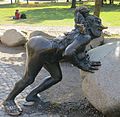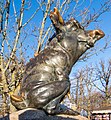Hexentanzplatz (Harz)
The Hexentanzplatz is a plateau ( 454 m above sea level ), which is located high above the Bodetal in the Harz, opposite the Roßtrappe in Saxony-Anhalt .
Geography and history
The Bodetal cable car leads from Thale to the Hexentanzplatz. There is also the Harzer Bergtheater Thale , one of the oldest natural theaters in Germany, with 1,350 seats, which was founded in 1903 by Ernst Wachler.
In the museum in the Walpurgishalle , which was built at the suggestion of the painter Hermann Hendrich , the saga of the Harz Mountains and scenes from Goethe's Faust come to life. There is also a sacrificial stone on display, which is reminiscent of ancient fertility rites.
Remains of the Sachsenwall stretch across the Hexentanzplatz . It is a 150 m long dry stone wall made of granite stones that were once 2 m high. It was made around 750 to 450 BC. Built in BC. The wall shielded parts of the elevated area of the Hexentanzplatz and probably served as a refuge .
There is also the Hexentanzplatz animal park, which represents the biodiversity of the Harz region with many different animal species; the Alpine-Coaster Harzbob ; as well as the Homburgswarte below the mountain theater .
The Hexentanzplatz is allegedly also an old Saxon place of worship where v. a. On the night of May 1st to worship the so-called Hagedisen (forest and mountain goddesses) festivals were held. The place only became a witch's dance place after the cult was banned by the immigrant Christian Franks . According to tradition, the place was guarded by Frankish soldiers to control the ban, who were chased away by Saxons disguised as witches and riding on brooms . Another old cult site of the Saxons is on the Brocken .
The mountain hotel of the same name has existed on Hexentanzplatz since the middle of the 19th century.
Walpurgishalle on the Hexentanzplatz
View from Hexentanzplatz into the Bodetal and the Roßtrappe rock massif
Figure group on the Hexentanzplatz
The sculptures on the Hexentanzplatz come from Jochen Müller , a qualified metal designer from Quedlinburg . They were unveiled on April 21, 1996. The main character in the middle of the chain of boulders is the devil . A homunculus sits on a stone at his feet . Wadelinde, the witch's grandmother, tries to close the circle of evil with a stone. Another figure, Jochen Müller's signpost to the square, dates from 2003.
literature
- Falko Kirsch, Bernd Ohlendorf: Guide through the Bodetal. History, geology, legends, flora, fauna. City of Thale, Thale im Harz 2010.
- Ute Fuhrmann, Rainer Vogt: The stones at the Hexentanzplatz. Thale and the surrounding area - rediscover a Harz landscape (= series of city stories. Vol. 1). 2nd Edition. Stekovics Verlag, Dößel 2007, ISBN 978-3-89923-116-8 .
Web links
- Hexentanzplatz ( Memento from March 7, 2014 in the Internet Archive )
Individual evidence
Coordinates: 51 ° 44 ′ 3 " N , 11 ° 1 ′ 43" E











